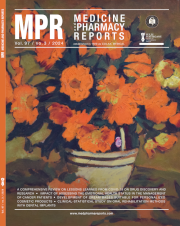Extra-digestive manifestations of celiac disease
DOI:
https://doi.org/10.15386/mpr-2776Keywords:
celiac disease, extra-digestive manifestations, autoimmune conditions, neurological symptoms, gluten-free dietAbstract
Introduction. Celiac disease (CD) is a chronic autoimmune disorder triggered by gluten ingestion in genetically predisposed individuals, presenting with a diverse range of symptoms that extend beyond the gastrointestinal tract. The condition’s systemic nature is evidenced by its extra-digestive manifestations, which can affect various organs including the skin, joints, liver, and nervous system.
Methods. This descriptive, retrospective study was conducted at a tertiary care center, focusing on adult patients diagnosed with CD who exhibited extra-digestive symptoms. Data were extracted from medical records of patients admitted between January 1, 2010 and June 30, 2024. Variables included demographic information, primary diagnosis, and associated extra-digestive manifestations. Descriptive statistical methods were employed for data analysis.
Results. The sample included 108 patients with CD, the mean age was 43.21 years, with a predominance of females (76.85%). Iron deficiency anemia was the most common extra-digestive manifestation, affecting 20.37% of patients, followed by hypoproteinemia (18.52%) and Hashimoto’s thyroiditis (14.81%). Co-occurrence analysis revealed frequent combinations of conditions, such as anemia with cardiovascular diseases and depressive disorders. Notable associations with neurological conditions like gluten ataxia and peripheral neuropathy were also observed.
Conclusion. This study highlights the extensive extra-digestive manifestations of celiac disease, underscoring its systemic impact. The high prevalence of autoimmune conditions such as Hashimoto’s thyroiditis and rheumatoid polyarthritis among CD patients reflects the need for holistic management strategies. Discrepancies between our findings and existing literature, particularly regarding skin and neurological conditions, emphasize the need for further research to better understand these associations and the long-term effects of a gluten-free diet.
Downloads
Published
How to Cite
Issue
Section
License
The authors are required to transfer the copyright of the published paper to the journal. This is done by agreeing to sign the Copyright Assignment Form. Whenever the case, authors are also required to send permissions to reproduce material (such as illustrations) from the copyright holder.

The papers published in the journal are licensed under a Creative Commons Attribution-NonCommercial-NoDerivatives 4.0 International License.

